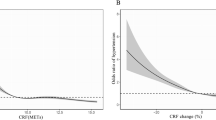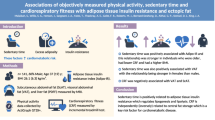Abstract
OBJECTIVE: To determine whether, for a given body mass index (BMI), men and women with high cardiorespiratory fitness (HIGH CRF) have lower waist circumference (WC), sum of trunk skinfolds (SUM2) and sum of five skinfolds (SUM5), by comparison to those with LOW CRF.
DESIGN: Observational cohort study.
SETTING: 1981 Canada Fitness Survey (CFS).
PARTICIPANTS:A total of 3719 men and 3854 women 20–59 y of age from the 1981 CFS for whom anthropometric and physical fitness measures were available.
MAIN OUTCOME MEASURES: BMI, waist circumference, skinfolds, cardiorespiratory fitness.
RESULTS: For a given BMI, men and women in the HIGH CRF group had lower WC, SUM2 and SUM5 by comparison to those with LOW CRF (P<0.001). A significant main effect for CRF group remained for SUM2 in both men (P=0.0001) and women (P=0.007), after statistical control for the effects of extremity fat. In women, but not men, there were significant interaction effects for WC (P=0.0023) and SUM5 (P=0.01), indicating that the difference between the LOW CRF and HIGH CRF groups increased with increasing BMI.
CONCLUSIONS: HIGH CRF is associated with lower levels of total and abdominal obesity for a given BMI by comparison to those with LOW CRF, independent of gender. This finding suggests a mechanism by which exercise attenuates the health risks attributed to obesity as measured by BMI. It is suggested that the routine measurement of WC and CRF would substantially improve the ability to identify those at health risk.
This is a preview of subscription content, access via your institution
Access options
Subscribe to this journal
Receive 12 print issues and online access
$259.00 per year
only $21.58 per issue
Buy this article
- Purchase on Springer Link
- Instant access to full article PDF
Prices may be subject to local taxes which are calculated during checkout


Similar content being viewed by others
References
World Health Organization. Obesity: preventing and managing the global epidemic. Report of a WHO Consultation on Obesity. World Health Organization: Geneva; 1998. WHO/NUT/NCD/98.1.1998.
Barlow CE, Kohl HW, Gibbons LW, Blair SN . Physical fitness, mortality and obesity. Int J Obes Relat Metab Disord 1995; 19: S41–S44.
Lee CD, Blair SN, Jackson AS . US weight guidelines: is it important to consider cardiorespiratory fitness? Int J Obes Relat Metab Disord 1998; 22: S2–S7.
Wei M, Kampert J, Barlow CE, Nichaman MZ, Gibbons LW, Paffenbarger RS, Blair SN . Relationship between low cardiorespiratory fitness and mortality in normal-weight, overweight, and obese men. JAMA 1999; 282: 1547–1553.
Ohlson LO, Larsson B, Svardsudd K, Welin L, Eriksson H, Wilhelmsen L, Bjorntosp P, Tibblin G . The influence of body fat distribution on the incidence of diabetes mellitus, 13.5 years of follow-up of the participants of the study of men born in 1913. Diabetes 1985; 34: 1055–1058.
Chan JM, Rimm EB, Colditz GA, Stampfer MJ, Willet WC . Obesity, fat distribution, and weight gain as risk factors for clinical diabetes in men. Diabetes Care 1994; 17: 961–969.
Rexrode KM, Carey VJ, Hennekens CH, Walters EE, Colditz GA, Stampfer MJ, Willet WC, Manson JE . Abdominal adiposity and coronary heart disease in women. JAMA 1998; 280: 1843–1848.
Després J-P, Moorjani S, Lupien PJ, Tremblay A, Nadeau A, Bouchard C . Regional distribution of body fat, plasma lipoproteins, and cardiovascular disease. Arteriosclerosis 1990; 10: 497–511.
Matsuzawa Y, Shimomura I, Nakamura T, Keon Y, Kotani K, Tokunaga K . Pathophysiology and pathogenesis of visceral fat obesity. Obese Res 1995; 3: (Suppl 3): S178–S194.
Ross R, Dagnone D, Jones PJH, Smith H, Paddags A, Hudson R, Janssen I . Reduction in obesity and related comorbid conditions after diet-induced weight loss or exercise-induced weight loss in men: A randomized controlled trial. Ann Intern Med 2000; 133: 92–103.
Mourier A, Gautier J-F, De Kerviler E, Bigard AX, Villetle JM, Garnier JP, Duvailet A, Guezennec CY, Cathelineav G . Mobilization of visceral adipose tissue related to the improvement in insulin sensitivity in response to physical training in NIDDM: effects of branched-chain amino acid supplements. Diabetes Care 1997; 20: 385–391.
Despres J-P . Visceral obesity, insulin resistance, and dyslipidemia: contribution of endurance exercise training to the plurimetabolic syndrome. Exerc Sport Sci Rev 1997; 25: 271–300.
Fitness Canada. Fitness and lifestyle in Canada. Ottawa: Government of Canada; 1983.
Fitness Canada. Standardized test of fitness: operations manual, 2nd edn. Ottawa, ON: Ministry of Fitness and Amateur Sport; 1981.
Jetté M, Campbell J, Mongeon J, Routhier R . The Canadian Home Fitness Test as a predictor for aerobic capacity. Can Med Assoc J 1976; 114: 680–682.
Jetté M . A calculator to predict maximal oxygen consumption for use with the Canadian Home Fitness Test. Can J Public Health 1977; 68: 195–198.
Shephard RJ . Fitness of a nation: lessons from the Canada Fitness Survey. New York: Karger; 1984.
Bouchard C, Landry F, Shephard RJ, Skinner J, Godin G . Report of the work group on constructing a physical activity index. In: Stephens T, Craig CL (eds). Proceedings of the workshop on assessing physical fitness and activity patterns in general population surveys. Hyattsville, MD: National Center for Health Statistics; 1985. pp 55–62.
SAS Institute. SAS/STAT users guide. Cary, NC: SAS Institute; 1988.
Lee CD, Blair SN, Jackson AS . Cardiorespiratory fitness, body composition, and all-cause and cardiovascular disease mortality in men. Am J Clin Nutr 1999; 69: 373–380.
Bouchard C . Genetics of aerobic power and capacity. In: Malina RM, Bouchard C (eds). Sport and human genetics. Champaign, IL: Human Kinetics; 1996. pp 59–88.
Pate RR, Pratt M, Blair SN, Haskell WL, Macera CA, Bouchard C, Buchner D, Ettinger W, Heath GW, King AC . Physical activity and public health: a recommendation for the Centers for Disease Control and Prevention and the American College of Sports Medicine. JAMA 1995; 273: 402–407.
Janssen I, Ross R . Effects of sex on the change in visceral, subcutaneous and skeletal muscle in response to weight loss. Int J Obes Relat Metab Disord 1999; 23: 1035–1046.
Ross R, Aru J, Freeman J, Hudson R, Janssen I . Abdominal adiposity and insulin resistance in obese men. Am J Physiol (Endo Metab) 2002; 282: E657–E663.
Goodpaster BH, Kelley DE, Wing RR, Meier A, Thaete FL . Effects of weight loss on regional fat distribution and insulin sensitivity in obesity. Diabetes 1999; 48: 839–847.
Allison DB, Zhu SK, Plankey M, Faith MS, Heo M . Differential associations of body mass index and adiposity with all-cause mortality among men in the first and second National Health and Nutrition Examination Surveys (NHANES I and NHANES II) follow-up studies. Int J Obes Relat Metab Disord 2002; 26: 410–416.
Kelley DE, Goodpaster BH . Skeletal muscle triglyceride. An aspect of regional adiposity and insulin resistance. Diabetes Care 2001; 24: 933–941.
Acknowledgements
Special thanks to Cora Craig and colleagues at the Canadian Fitness and Lifestyle Research Institute for providing the CFS database. This research was funded, in part, by the Canadian Institutes for Health Research (MT 13448) and the Heart and Stroke Foundation of Canada (#T-4946).
Author information
Authors and Affiliations
Corresponding author
Rights and permissions
About this article
Cite this article
Ross, R., Katzmarzyk, P. Cardiorespiratory fitness is associated with diminished total and abdominal obesity independent of body mass index. Int J Obes 27, 204–210 (2003). https://doi.org/10.1038/sj.ijo.802222
Received:
Revised:
Accepted:
Published:
Issue Date:
DOI: https://doi.org/10.1038/sj.ijo.802222
Keywords
This article is cited by
-
Validity and reliability of the measurement instrument of the nursing outcome health-related Physical Fitness (2004), proposed and transculturally adapted to the Spanish context
BMC Nursing (2022)
-
Body surface scan anthropometrics are related to cardiorespiratory fitness in the general population
Scientific Reports (2022)
-
Association between cardiorespiratory fitness and the prevalence of metabolic syndrome among Korean adults: a cross sectional study
BMC Public Health (2014)
-
Waist circumference vs body mass index in association with cardiorespiratory fitness in healthy men and women: a cross sectional analysis of 403 subjects
Nutrition Journal (2013)
-
Low Cardiorespiratory Fitness in African Americans: A Health Disparity Risk Factor?
Sports Medicine (2013)



